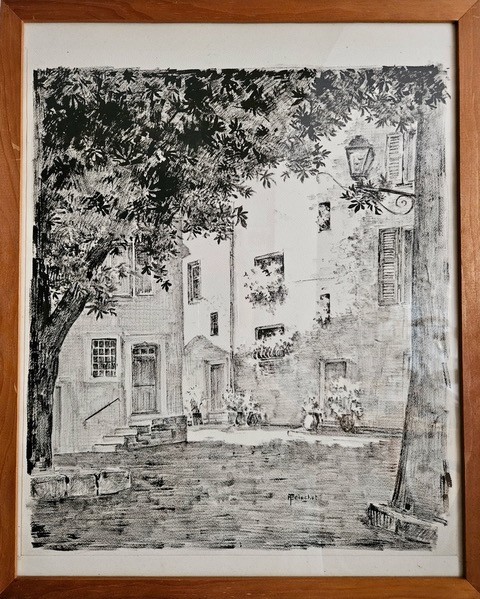He was one of the founders of radio astronomy in France, along with Jean-Louis Steinberg, Jean-François Denisse and their team, at the Ecole Normale Supérieure and then at the Observatoire de Paris. He contributed to the development of the first large solar radio interferometer with 32 VHF antennas (169 MHz) at Nançay (the precursor of the Radio Heliograph), with which he made one of his most important discoveries : a new class of solar bursts, known as "Type IV", which anticipated the discovery a decade later of mass ejections from the solar corona. With J.-F. Denisse, he linked this type of emission to the energetic charged particles that the Sun accelerates and that are then detected at Earth level. Their ideas on acceleration scenarios, involving shock waves in particular, have been echoed to this day. This work was the subject of his thesis1.
Together with engineers Carlo Rosolen and Maurice Du Chaffaut, André Boischot and Jérôme de la Noë developed two frequency scanning receivers, which they first installed at the foot of two log-periodic antennas in Nançay, then took to the Arecibo radio telescope in 1970 to carry out the first broadband spectral observations of the Sun between 20 and 80 MHz. These observations showed for the first time the fine polarised structures that accompany Type III bursts, which are still being studied today.
In addition to his studies of the Sun, André Boischot took part in the first observations with the Grand Radiotélescope de Nançay in the 1960s (remnants of supernovae, clusters of galaxies, thermal emission from Venus). But it was the study of magnetised planets that was at the heart of his work from the late 1970s onwards.
André Boischot founded the "Groupe de Radioastronomie Décamétrique" (Decametric Radio Astronomy Group) at the Meudon Observatory, with which he built the Decametric Network at the "Station de Radioastronomie de Nançay" (now the "Observatoire Radioastronomique de Nançay") in 1976-77, to carry out wide-band spectral and high-sensitivity studies, then in polarisation and at high temporal and spectral resolutions, of low-frequency radio emissions (≤100 MHz) from Jupiter and the Sun. This instrument, made up of 144 log-helical antennae built at Nançay itself, was also an important ’ground support’ for the Voyager 1 & 2 probes. André Boischot and the Groupe Décamétrique2, several members of which were co-investigators or associate investigators in the Planetary Radio Astronomy (PRA) experiment on board each of the two probes, thus played a full part in the fabulous ’Voyager’ adventure to discover the outer solar system : Jupiter, Saturn, Uranus and Neptune. This adventure had a lasting influence on the research of all the members of the Group, as well as part of the Observatory’s space laboratory (DESPA, then LESIA), which was involved in the Ulysses and Cassini missions, and inspired collaborations with plasma theorists (in particular the late Dominique Le Quéau).

In the mid-1980s, along with Arturo Ortega-Molina and François Biraud, André took part in the intercontinental interferometry (VLBI3) monitoring of the balloons released into the atmosphere of Venus by the Soviet VEGA mission. He then worked with CNES and ESA on studies to extend VLBI to space (the QUASAT project, which unfortunately never saw the light of day).
André Boischot was always keen to promote and develop radio astronomy, through summary articles in encyclopaedias (Universalis, Flammarion), a book in the "Que Sais-Je ?" collection, and a number of historical articles in 2009-2011. He also taught Radio Astronomy at Masters level in the early 1980s (and inspired a number of vocations).
He left the Groupe Décamétrique and the Paris region shortly after the Voyager 2-Neptune encounter in 1989. After a brief collaboration with the CERGA in Grasse, to support the development of optical interferometry, André effectively retired in the mid-1990s.
He was then able to devote himself fully to his second passion, painting, watercolours and drawing, a field in which he was equally prolific.

On 4 October 2017, the 40th anniversary of the Réseau Décamétrique (still active today) was held in Nançay. To our immense pleasure, this anniversary brought together the pioneers - including André himself - and subsequent generations of researchers, engineers and technicians who have worked on or with this instrument (https://archives-decametriques.obspm.fr/radiotelescopes/le-reseau-decametrique-de-nancay/).
André was appreciated by all those who came into contact with him - French and foreign colleagues, doctoral students, students, many of whom became friends - for the quality of his scientific work, of course, but also for his synthetic and visionary spirit, a source of inspiration for many, and for his enlightened and benevolent leadership. His kindness and generosity were matched only by his unwavering optimism. He leaves us with nothing but fond memories, combined with the sadness of his passing. His legacy lives on.
On the occasion of this tribute, we would like to spare a thought for his wife Michelle, who passed away in 2016. She was an unfailing supporter of André, and her human qualities left an indelible mark on all those who knew her.
1 A. Boischot, Etude du rayonnement radioélectrique solaire sur 169 Mhz, à l’aide d’un grand interféromètre à réseau, Thesis, 1958.
2 Yolande Leblanc(†), Bent Pedersen(†), Monique Aubier, Alain Lecacheux, Françoise Genova, Gérard Daigne(†), Arturo Ortega-Molina, Philippe Zarka
3 Very Long Baseline Interferometry


